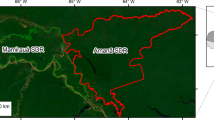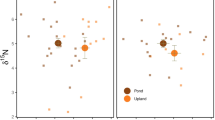Abstract
Daytime observations on the isopods Idotea phosphorea and I. baltica and the amphipod Gammarus oceanicus held in laboratory microcosms showed that I. phosphorea and G. oceanicus spent 45% and 30% respectively, of their active time feeding on dead, intact eelgrass leaves which had been recently released from plants. I. baltica spent 41% of its active time consuming intact green leaves. The shredding of intact dead leaves by I. phosphorea and G. oceanicus resulted in production of small detrital particles which were liberated from the faeces of the invertebrates and this type of feeding led to the breakdown of whole leaves. Field experiments which separated the effects of shredding by invertebrates and grinding by waves and ice on the loss of weight from leaf packs showed that relative to controls isopods significantly increased weight loss from dead leaves. Loss of weight from leaf packs exposed to both biotic and physical shredding forces was not significantly different from that found on those exposed only to shredding by isopods. However, trends in the data indicated that fragmentation of whole, dead leaves in the field probably is a result of the synergistic effects of shredding by invertebrates and physical factors, particularly ice grinding. The role played by invertebrates in fragmenting intact, dead leaves is discussed in the light of energy flow and nutrient cycling within seagrass systems.
Similar content being viewed by others
Literatured Cited
Cummins, K. W.: Structure and function of stream ecosystems. Bioscience 24, 631–641 (1974)
Fenchel, T.: Studies on the decomposition of organic detritus derived from the turtle grass Thalassia testudinum. Limnol. Oceanogr. 15, 14–20 (1970)
Fenchel, T.: Aspects of the decomposition of seagrasses. In: Seagrass ecosystems: A scientific perspective, pp 123–145. Ed. by C. P. McRoy and C. Helfferich. New York: Marcel Dekker Inc. (1977)
Godshalk, G. L. and R. G. Wetzel: Decomposition of aquatic angiosperms. III. Zostera marina L. and a conceptual model of decomposition. Aquatic Bot. 5, 301–328 (1978)
Gosselink, J. G. and C. J. Kirby: Decomposition of salt marsh grass, Spartina alterniflora Loisel. Limnol. Oceanogr. 19, 825–832 (1974)
Harrison, P. G.: Decomposition of macrophyte detritus in seawater: effects of grazing by amphipods. Oikos 28, 165–170 (1977)
Harrison, P. G. and K. H. Mann: Chemical changes during the seasonal cycle of growth and decay in eelgrass (Zostera marina) on the Atlantic coast of Canada. J. Fish. Res. Bd Can. 32, 615–621 (1975a)
Harrison, P. G. and K. H. Mann: Detritus formation from eelgrass (Zostera marina): the relative effects of fragmentation, leaching and decay. Limnol. Oceanogr. 20, 924–934 (1975b)
Levinton, J. S.: Stability and trophic structure in deposit-feeding and suspension feeding communities. Am. Nat. 106, 472–486 (1972)
Lopez, G. R., J. S. Levinton and L. B. Slobodkin: The effect of grazing by the detritivore Orchestra grillus on Spartina litter and its associated microbial community. Oecologia 30, 111–128 (1977)
Mann, K. H.: Decomposition of marine macrophytes. In: The role of terrestrial and aquatic organisms in decomposition processes, pp 247–267. Ed. by J. M. Anderson and A. Macfayden. 17th Symposium of the British Ecological Society. (1975)
Petersen, R. C. and K. W. Cummins: Leaf processing in a woodland stream. Freshwater Biol. 4, 343–368 (1974)
Reice, S. R.: The role of animal associations and current velocity in sedement-specific leaf litter decomposition. Oikos 29, 357–365 (1977)
Valiela, I., L. Koumjian, T. Swain, J. M. Teal and J. E. Hobbie: Cinnamic acid inhibition of detritus feeding. Nature, Lond. 280, 55–57 (1979)
Weish, B. L.: The role of grass shrimp, Paleomonetes pugio in a tidal marsh ecosystem. Ecology 56, 513–530 (1975)
Wetzel, R. G.: Limnology. 743 pp. Philadelphia: Sanders 1975
Zieman, J. C., J. C. Ogden and G. W. Thayer: Consumer functions, interactions and dynamics. In: Seagrass three objectives: seagrass ecosystem study, pp 47–53. Seagrass Ecosystem Study Office, University of Hawaii, USA (1978)
Author information
Authors and Affiliations
Additional information
Communicated by R. O. Fournier, Halifax
Rights and permissions
About this article
Cite this article
Robertson, A.I., Mann, K.H. The role of isopods and amphipods in the initial fragmentation of eelgrass detritus in Nova Scotia, Canada. Mar. Biol. 59, 63–69 (1980). https://doi.org/10.1007/BF00396983
Accepted:
Issue Date:
DOI: https://doi.org/10.1007/BF00396983




